What is the term for metabolic pathways that release stored energy by breaking down complex molecules?
A) anabolic pathways
B) catabolic pathways
C) fermentation pathways
D) thermodynamic pathways
E) bioenergetic pathways
Answer: B
The molecule that functions as the reducing agent (electron donor) in a redox or oxidation-reduction reaction
A) gains electrons and gains energy.
B) loses electrons and loses energy.
C) gains electrons and loses energy.
D) loses electrons and gains energy.
E) neither gains nor loses electrons, but gains or loses energy.
Answer: B
When electrons move closer to a more electronegative atom, what happens?
A) Energy is released.
B) Energy is consumed.
C) The more electronegative atom is reduced.
D) The more electronegative atom is oxidized.
E) A and C are correct.
Answer: E
Why does the oxidation of organic compounds by molecular oxygen to produce CO2 and water release free energy?
A) The covalent bonds in organic molecules are higher energy bonds than those in water and carbon dioxide.
B) Electrons are being moved from atoms that have a lower affinity for electrons (such as C) to atoms with a higher affinity for electrons (such as O).
C) The oxidation of organic compounds can be used to make ATP.
D) The electrons have a higher potential energy when associated with water and CO 2 than they do in organic compounds.
E) The covalent bond in O2 is unstable and easily broken by electrons from organic molecules.
Answer: B
Which of the following statements describes the results of this reaction? C6H12O6 + 6 O2 → 6 CO2 + 6 H2O + Energy
A) C6H12O6 is oxidized and O2 is reduced.
B) O2 is oxidized and H2O is reduced.
C) CO2 is reduced and O2 is oxidized.
D) C6H12O6 is reduced and CO2 is oxidized.
E) O2 is reduced and CO2 is oxidized.
Answer: A
When a glucose molecule loses a hydrogen atom as the result of an oxidation-reduction reaction, the molecule becomes
A) dehydrogenated.
B) hydrogenated.
C) oxidized.
D) reduced.
E) an oxidizing agent.
Answer: C
When a molecule of NAD+ (nicotinamide adenine dinucleotide) gains a hydrogen atom (not a hydrogen ion) the molecule becomes
A) hydrogenated.
B) oxidized.
C) reduced.
D) redoxed.
E) a reducing agent.
Answer: C
Which of the following statements describes NAD+?
A) NAD+ is reduced to NADH during both glycolysis and the citric acid cycle.
B) NAD+ has more chemical energy than NADH.
C) NAD+ is reduced by the action of hydrogenases.
D) NAD+ can donate electrons for use in oxidative phosphorylation.
E) In the absence of NAD+, glycolysis can still function.
Answer: A
Where does glycolysis takes place?
A) mitochondrial matrix
B) mitochondrial outer membrane
C) mitochondrial inner membrane
D) mitochondrial intermembrane space
E) cytosol
Answer: E
The ATP made during glycolysis is generated by
A) substrate-level phosphorylation.
B) electron transport.
C) photophosphorylation.
D) chemiosmosis.
E) oxidation of NADH to NAD+.
Answer: A
The oxygen consumed during cellular respiration is involved directly in which process or event?
A) glycolysis
B) accepting electrons at the end of the electron transport chain
C) the citric acid cycle
D) the oxidation of pyruvate to acetyl CoA
E) the phosphorylation of ADP to form ATP
Answer: B
Which process in eukaryotic cells will proceed normally whether oxygen (O2) is present or absent?
A) electron transport
B) glycolysis
C) the citric acid cycle
D) oxidative phosphorylation
E) chemiosmosis
Answer: B
An electron loses potential energy when it
A) shifts to a less electronegative atom.
B) shifts to a more electronegative atom.
C) increases its kinetic energy.
D) increases its activity as an oxidizing agent.
E) attaches itself to NAD+.
Answer: B
Why are carbohydrates and fats considered high energy foods?
A) They have a lot of oxygen atoms.
B) They have no nitrogen in their makeup.
C) They can have
very long carbon skeletons.
D) They have a lot of electrons
associated with hydrogen.
E) They are easily reduced.
Answer: D
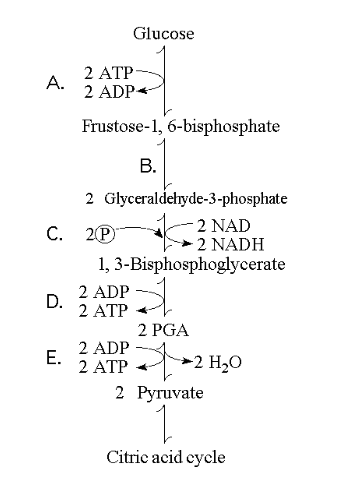
Which step shows a split of one molecule into two smaller molecules?
Answer: B
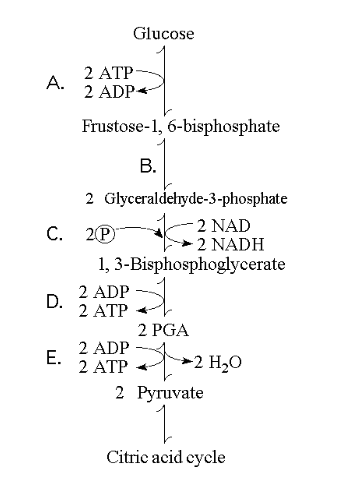
In which step is an inorganic phosphate added to the reactant?
Answer: C
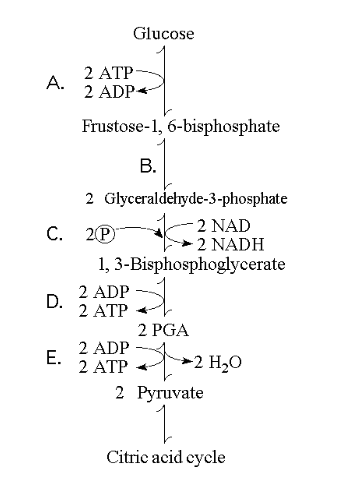
In which reaction does an intermediate pathway become oxidized?
Answer: C
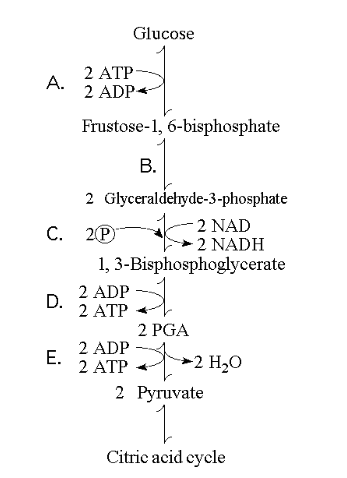
Which step involves an endergonic reaction?
Answer: A
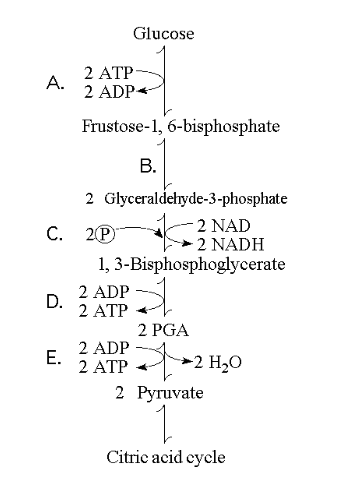
Which step consists of a phosphorylation reaction in which ATP is the phosphate source?
Answer: A
Substrate-level phosphorylation accounts for approximately what percentage of the ATP formed during glycolysis?
A) 0%
B) 2%
C) 10%
D) 38%
E) 100%
Answer: E
During glycolysis, when glucose is catabolized to pyruvate, most of the energy of glucose is
A) transferred to ADP, forming ATP.
B) transferred directly to ATP.
C) retained in the pyruvate.
D) stored in the NADH produced.
E) used to phosphorylate fructose to form fructose-6-phosphate.
Answer: C
In addition to ATP, what are the end products of glycolysis?
A) CO2 and H2O
B) CO2 and pyruvate
C) NADH and pyruvate
D) CO2 and NADH
E) H2O, FADH2, and citrate
Answer: C
The free energy for the oxidation of glucose to CO2 and water is -686 kcal/mole and the free energy for the reduction of NAD+ to NADH is +53 kcal/mole. Why are only two molecules of NADH formed during glycolysis when it appears that as many as a dozen could be formed?
A) Most of the free energy available from the oxidation of glucose is used in the production of ATP in glycolysis.
B) Glycolysis is a very inefficient reaction, with much of the energy of glucose released as heat.
C) Most of the free energy available from the oxidation of glucose remains in pyruvate, one of the products of glycolysis
D) There is no CO2 or water produced as products of glycolysis.
E) Glycolysis consists of many enzymatic reactions, each of which extracts some energy from the glucose molecule.
Answer: C
Starting with one molecule of glucose, the ʺnetʺ products of glycolysis are A) 2 NAD+, 2 H+, 2 pyruvate, 2 ATP, and 2 H2O.
B) 2 NADH, 2 H+, 2 pyruvate, 2 ATP, and 2 H2O.
C) 2 FADH2, 2 pyruvate, 4 ATP, and 2 H2O.
D) 6 CO2, 6 H2O, 2 ATP, and 2 pyruvate.
E) 6 CO2, 6 H2O, 36 ATP, and 2 citrate.
Answer: B
In glycolysis, for each molecule of glucose oxidized to pyruvate
A) 2 molecules of ATP are used and 2 molecules of ATP are produced.
B) 2 molecules of ATP are used and 4 molecules of ATP are produced.
C) 4 molecules of ATP are used and 2 molecules of ATP are produced.
D) 2 molecules of ATP are used and 6 molecules of ATP are produced.
E) 6 molecules of ATP are used and 6 molecules of ATP are produced.
Answer: B
A molecule that is phosphorylated
A) has been reduced as a result of a redox reaction involving the loss of an inorganic phosphate.
B) has a decreased chemical reactivity; it is less likely to provide energy for cellular work.
C) has been oxidized as a result of a redox reaction involving the gain of an inorganic phosphate.
D) has an increased chemical reactivity; it is primed to do cellular work.
E) has less energy than before its phosphorylation and therefore less energy for cellular work.
Answer: D
Which kind of metabolic poison would most directly interfere with glycolysis?
A) an agent that reacts with oxygen and depletes its concentration in the cell
B) an agent that binds to pyruvate and inactivates it
C) an agent that closely mimics the structure of glucose but is not metabolized
D) an agent that reacts with NADH and oxidizes it to NAD +
E) an agent that blocks the passage of electrons along the electron transport chain
Answer: C
Why is glycolysis described as having an investment phase and a payoff phase?
A) It both splits molecules and assembles molecules.
B) It attaches and detaches phosphate groups.
C) It uses glucose and generates pyruvate.
D) It shifts molecules from cytosol to mitochondrion.
E) It uses stored ATP and then forms a net increase in ATP.
Answer: E
In the presence of oxygen, the three-carbon compound pyruvate can be catabolized in the citric acid cycle. First, however, the pyruvate 1) loses a carbon, which is given off as a molecule of CO2, 2) is oxidized to form a two-carbon compound called acetate, and 3) is bonded to coenzyme A.
These three steps result in the formation of
A) acetyl CoA, O2, and ATP.
B) acetyl CoA, FADH2, and CO2.
C) acetyl CoA, FAD, H2, and CO2.
D) acetyl CoA, NADH, H+, and CO2.
E) acetyl CoA, NAD+, ATP, and CO2.
Answer: D
In the presence of oxygen, the three-carbon compound pyruvate can be catabolized in the citric acid cycle. First, however, the pyruvate 1) loses a carbon, which is given off as a molecule of CO2, 2) is oxidized to form a two-carbon compound called acetate, and 3) is bonded to coenzyme A.
Why is coenzyme A, a sulfur containing molecule derived from a B vitamin, added?
A) because sulfur is needed for the molecule to enter the mitochondrion
B) in order to utilize this portion of a B vitamin which would otherwise be a waste product from another pathway
C) to provide a relatively unstable molecule whose acetyl portion can readily bind to oxaloacetate
D) because it drives the reaction that regenerates NAD+
E) in order to remove one molecule of CO2
Answer: C
How does pyruvate enter the mitochondrion?
A) active transport
B) diffusion
C) facilitated diffusion
D) through a channel
E) through a pore
Answer: A
Which of the following intermediary metabolites enters the citric acid cycle and is formed, in part, by the removal of a carbon (CO2) from one molecule of pyruvate?
A) lactate
B) glyceraldehydes-3-phosphate
C) oxaloacetate
D) acetyl CoA
E) citrate
Answer: D
During cellular respiration, acetyl CoA accumulates in which location?
A) cytosol
B) mitochondrial outer membrane
C) mitochondrial inner membrane
D) mitochondrial intermembrane space
E) mitochondrial matrix
Answer: E
How many carbon atoms are fed into the citric acid cycle as a result of the oxidation of one molecule of pyruvate?
A) 2
B) 4
C) 6
D) 8
E) 10
Answer: A
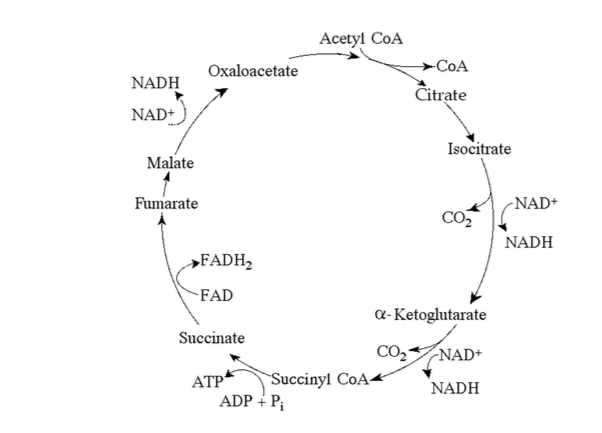
Starting with one molecule of isocitrate and ending with fumarate, what is the maximum number of ATP molecules that could be made through substrate-level phosphorylation?
A) 1
B) 2
C) 11
D) 12
E) 24
Answer: A
Carbon skeletons for amino acid biosynthesis are supplied by intermediates of the citric acid cycle. Which intermediate would supply the carbon skeleton for synthesis of a five-carbon amino acid?
A) succinate
B) malate
C) citrate
D) α-ketoglutarate
E) isocitrate
Answer: D
How many molecules of carbon dioxide (CO2) would be produced by five turns of the citric acid cycle?
A) 2
B) 5
C) 10
D) 12
E) 60
Answer: C
How many reduced dinucleotides would be produced with four turns of the citric acid cycle?
A) 1 FADH2 and 4 NADH
B) 2 FADH2 and 8 NADH
C) 4 FADH2 and 12 NADH
D) 1 FAD and 4 NAD+
E) 4 FAD+ and 12 NAD+
Answer: C
Starting with citrate, which of the following combinations of products would result from three turns of the citric acid cycle?
A) 1 ATP, 2 CO2, 3 NADH, and 1 FADH2
B) 2 ATP, 2 CO2, 1 NADH, and 3 FADH2
C) 3 ATP, 3 CO2, 3 NADH, and 3 FADH2
D) 3 ATP, 6 CO2, 9 NADH, and 3 FADH2
E) 38 ATP, 6 CO2, 3 NADH, and 12 FADH2
Answer: D
Carbon dioxide (CO2) is released during which of the following stages of cellular respiration?
A) glycolysis and the oxidation of pyruvate to acetyl CoA
B) oxidation of pyruvate to acetyl CoA and the citric acid cycle
C) the citric acid cycle and oxidative phosphorylation
D) oxidative phosphorylation and fermentation
E) fermentation and glycolysis
Answer: B
For each molecule of glucose that is metabolized by glycolysis and the citric acid cycle, what is the total number of NADH + FADH2 molecules produced?
A) 4
B) 5
C) 6
D) 10
E) 12
Answer: E
A young animal has never had much energy. He is brought to a veterinarian for help and is sent to the animal hospital for some tests. There they discover his mitochondria can use only fatty acids and amino acids for respiration, and his cells produce more lactate than normal. Of the following, which is the best explanation of his condition?
A) His mitochondria lack the transport protein that moves pyruvate across the outer mitochondrial membrane.
B) His cells cannot move NADH from glycolysis into the mitochondria.
C) His cells contain something that inhibits oxygen use in his mitochondria.
D) His cells lack the enzyme in glycolysis that forms pyruvate.
E) His cells have a defective electron transport chain, so glucose goes to lactate instead of to acetyl CoA.
Answer: A
Cellular respiration harvests the most chemical energy from which of the following?
A) substrate-level phosphorylation
B) chemiosmotic phosphorylation
C) converting oxygen to ATP
D) transferring electrons from organic molecules to pyruvate
E) generating carbon dioxide and oxygen in the electron transport chain
Answer: B
During aerobic respiration, electrons travel downhill in which sequence? A) food → citric acid cycle → ATP → NAD+
B) food → NADH → electron transport chain → oxygen
C) glucose → pyruvate → ATP → oxygen
D) glucose → ATP → electron transport chain → NADH
E) food → glycolysis → citric acid cycle → NADH → ATP
Answer: B
Where are the proteins of the electron transport chain located?
A) cytosol
B) mitochondrial outer membrane
C) mitochondrial inner membrane
D) mitochondrial intermembrane space
E) mitochondrial matrix
Answer: C
Which of the following describes the sequence of electron carriers in the electron transport chain, starting with the least electronegative?
A) ubiquinone (Q), cytochromes (Cyt), FMN, Fe•S
B) cytochromes (Cyt), FMN, ubiquinone, Fe•S
C) Fe•S, FMN, cytochromes (Cyt), ubiquinone
D) FMN, Fe•S, ubiquinone, cytochromes (Cyt)
E) cytochromes (Cyt), Fe•S, ubiquinone, FMN
Answer: D
During aerobic respiration, which of the following directly donates electrons to the electron transport chain at the lowest energy level?
A) NAD+
B) NADH
C) ATP
D) ADP + Pi
E) FADH2
Answer: E
The primary role of oxygen in cellular respiration is to
A) yield energy in the form of ATP as it is passed down the respiratory chain.
B) act as an acceptor for electrons and hydrogen, forming water.
C) combine with carbon, forming CO2.
D) combine with lactate, forming pyruvate.
E) catalyze the reactions of glycolysis.
Answer: B
Inside an active mitochondrion, most electrons follow which pathway?
A) glycolysis → NADH → oxidative phosphorylation → ATP → oxygen
B) citric acid cycle → FADH2 → electron transport chain → ATP
C) electron transport chain → citric acid cycle → ATP → oxygen
D) pyruvate → citric acid cycle → ATP → NADH → oxygen
E) citric acid cycle → NADH → electron transport chain → oxygen
Answer: E
During oxidative phosphorylation, H2O is formed. Where does the oxygen for the synthesis of the water come from?
A) carbon dioxide (CO2)
B) glucose (C6H12O6)
C) molecular oxygen (O2)
D) pyruvate (C3H3O3-)
E) lactate (C3H5O3-)
Answer: C
In chemiosmotic phosphorylation, what is the most direct source of energy that is used to convert ADP + Pi to ATP?
A) energy released as electrons flow through the electron transport system
B) energy released from substrate-level phosphorylation
C) energy released from ATP synthase pumping hydrogen ions from the mitochondrial matrix
D) energy released from movement of protons through ATP synthase
E) No external source of energy is required because the reaction is exergonic.
Answer: D
Energy released by the electron transport chain is used to pump H + ions into which location?
A) cytosol
B) mitochondrial outer membrane
C) mitochondrial inner membrane
D) mitochondrial intermembrane space
E) mitochondrial matrix
Answer: D
The direct energy source that drives ATP synthesis during respiratory oxidative phosphorylation is
A) oxidation of glucose to CO2 and water.
B) the thermodynamically favorable flow of electrons from NADH to the mitochondrial electron transport carriers.
C) the final transfer of electrons to oxygen.
D) the difference in H+ concentrations on opposite sides of the inner mitochondrial membrane.
E) the thermodynamically favorable transfer of phosphate from glycolysis and the citric acid cycle intermediate molecules of ADP.
Answer: D
When hydrogen ions are pumped from the mitochondrial matrix across the inner membrane and into the intermembrane space, the result is the
A) formation of ATP.
B) reduction of NAD+.
C) restoration of the Na+/K+ balance across the membrane.
D) creation of a proton gradient.
E) lowering of pH in the mitochondrial matrix.
Answer: D
Where is ATP synthase located in the mitochondrion?
A) cytosol
B) electron transport chain
C) outer membrane
D) inner membrane
E) mitochondrial matrix
Answer: D
It is possible to prepare vesicles from portions of the inner membrane of the mitochondrial components. Which one of the following processes could still be carried on by this isolated inner membrane?
A) the citric acid cycle
B) oxidative phosphorylation
C) glycolysis and fermentation
D) reduction of NAD+
E) both the citric acid cycle and oxidative phosphorylation
Answer: B
Each time a molecule of glucose (C6H12O6) is completely oxidized via aerobic respiration, how many oxygen molecules (O2) are required?
A) 1
B) 2
C) 6
D) 12
E) 38
Answer: C
Which of the following produces the most ATP when glucose (C6H12O6) is completely oxidized to carbon dioxide (CO2) and water?
A) glycolysis
B) fermentation
C) oxidation of pyruvate to acetyl CoA
D) citric acid cycle
E) oxidative phosphorylation (chemiosmosis)
Answer: E
Approximately how many molecules of ATP are produced from the complete oxidation of two molecules of glucose (C6H12O6) in cellular respiration?
A) 2
B) 4
C) 15
D) 38
E) 76
Answer: E
Assume a mitochondrion contains 58 NADH and 19 FADH2. If each of the 77 dinucleotides were used, approximately how many ATP molecules could be generated as a result of oxidative phosphorylation (chemiosmosis)?
A) 36
B) 77
C) 173
D) 212
E) 1102
Answer: D
Approximately what percentage of the energy of glucose (C6H12O6) is transferred to storage in ATP as a result of the complete oxidation of glucose to CO2 and water in cellular respiration?
A) 2%
B) 4%
C) 10%
D) 25%
E) 40%
Answer: E
Recall that the complete oxidation of a mole of glucose releases 686 kcal of energy (Δ G = -686 kcal/mol). The phosphorylation of ADP to form ATP stores approximately 7.3 kcal per mole of ATP. What is the approximate efficiency of cellular respiration for a ʺmutantʺ organism that produces only 29 moles of ATP for every mole of glucose oxidized, rather than the usual 36-38 moles of ATP?
A) 0.4%
B) 25%
C) 30%
D) 40%
E) 60%
Answer: C
What is proton-motive force?
A) the force required to remove an electron from hydrogen
B) the transmembrane proton concentration gradient
C) movement of hydrogen into the intermembrane space
D) movement of hydrogen into the mitochondrion
E) the addition of hydrogen to NAD+
Answer: B
In liver cells, the inner mitochondrial membranes are about 5 X the area of the outer mitochondrial membranes, and about 17 X that of the cellʹs plasma membrane. What purpose must this serve?
A) It allows for increased rate of glycolysis.
B) It allows
for increased rate of the citric acid cycle.
C) It increases the surface for oxidative phosphoryation.
D)
It increases the surface for substrate-level phosphorylation.
E) It allows the liver cell to have fewer mitochondria.
Answer: C
Exposing inner mitochondrial membranes to ultrasonic vibrations will disrupt the membranes. However, the fragments will reseal ʺinside out.ʺ These little vesicles that result can still transfer electrons from NADH to oxygen and synthesize ATP. If the membranes are agitated still further however, the ability to synthesize ATP is lost.
After the first disruption, when electron transfer and ATP synthesize still occur, what must be present?
A) all of the electron transport proteins as well as ATP synthase
B) all of the electron transport system and the ability to add CoA to acetyl groups
C) the ATP synthase system is sufficient
D) the electron transport system is sufficient
E) plasma membranes like those bacteria use for respiration
Answer: A
Exposing inner mitochondrial membranes to ultrasonic vibrations will disrupt the membranes. However, the fragments will reseal ʺinside out.ʺ These little vesicles that result can still transfer electrons from NADH to oxygen and synthesize ATP. If the membranes are agitated still further however, the ability to synthesize ATP is lost.
After the second agitation of the membrane vesicles, what must be lost from the membrane?
A) the ability of NADH to transfer electrons to the first acceptor in the electron transport chain
B) the prosthetic groups like heme from the transport system
C) cytochromes
D) ATP synthase, in whole or in partuter membrane surfaces
Answer: D
Exposing inner mitochondrial membranes to ultrasonic vibrations will disrupt the membranes. However, the fragments will reseal ʺinside out.ʺ These little vesicles that result can still transfer electrons from NADH to oxygen and synthesize ATP. If the membranes are agitated still further however, the ability to synthesize ATP is lost.
It should be possible to reconstitute the abilities of the vesicles if which of the following is added?
A) cytochromes
B) extra NADH
C) a second membrane surface
D) more electrons
E) intact ATP synthase
Answer: E
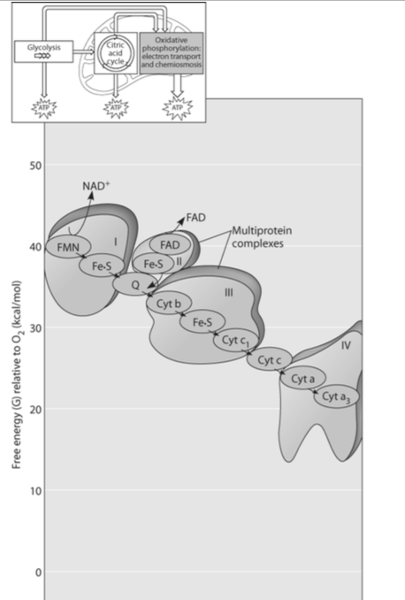
The accompanying figure shows the electron transport chain. Which of the following is the combination of substances that is initially added to the chain?
A) oxygen, carbon dioxide, and water
B) NAD+ , FAD, and electrons
C) NADH, FADH2, and protons
D) NADH, FADH2, and electrons
E) Oxygen and electrons
Answer: D
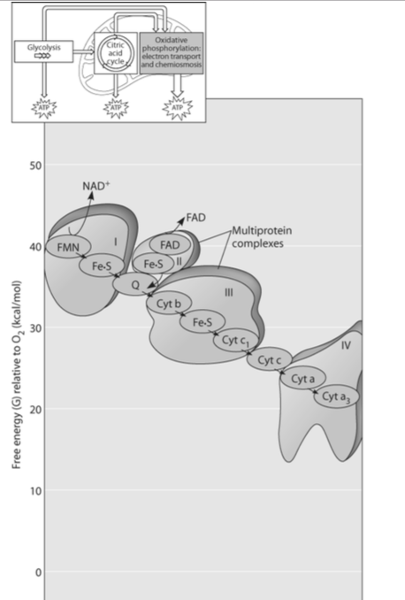
Which of the following most accurately describes what is happening along this chain?
A) Chemiosmosis is coupled with electron transfer.
B) Each electron carrier alternates between being reduced and being oxidized.
C) ATP is generated at each step.
D) Energy of the electrons increases at each step.
E) Molecules in the chain give up some of their potential energy.
Answer: B
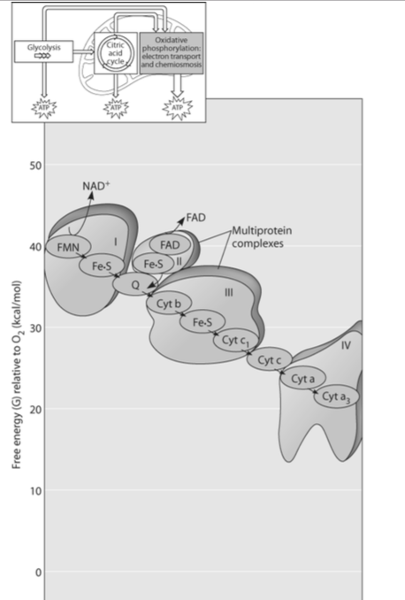
The parts of the figure labeled with Roman numerals symbolize what concept?
A) different inner mitochondrial membranes
B) different mitochondria functioning together
C) molecules with different attached metal ions
D) carbohydrate framework holding the molecules in place
E) multimeric groups of proteins in 4 complexes
Answer: E
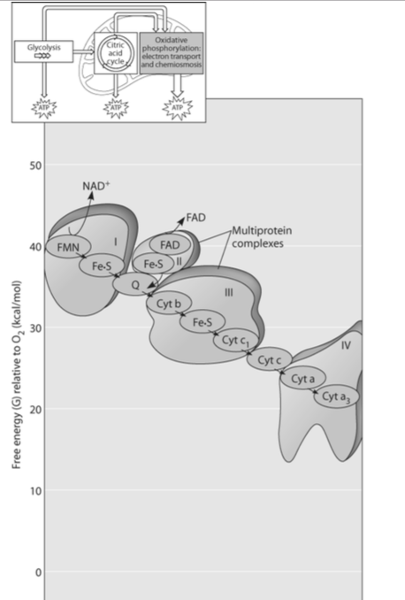
What happens at the end of the chain?
A) The 2 original electrons combine with NAD+.
B) The 2 original electrons combine with oxygen.
C) 4 electrons combine with oxygen and protons.
D) 4 electrons combine with hydrogen and oxygen atoms.
E) 1 electron combines with oxygen and hydrogen.
Answer: C
Which of the following couples chemiosmosis to energy storage?
A) NADH
B) FADH2
C) cytochromes
D) electron transport
E) ATP synthase
Answer: E
Which of the following describes ubiquinone?
A) a protein in the electron transport chain
B) a small hydrophobic coenzyme
C) a substrate for synthesis of FADH
D) a vitamin needed for efficient glycolysis
E) an essential amino acid
Answer: B
Which of the following normally occurs whether or not oxygen (O2) is present?
A) glycolysis
B) fermentation
C) oxidation of pyruvate to acetyl CoA
D) citric acid cycle
E) oxidative phosphorylation (chemiosmosis)
Answer: A
Which of the following occurs in the cytosol of a eukaryotic cell?
A) glycolysis and fermentation
B) fermentation and chemiosmosis
C) oxidation of pyruvate to acetyl CoA
D) citric acid cycle
E) oxidative phosphorylation
Answer: A
Which metabolic pathway is common to both cellular respiration and fermentation?
A) the oxidation of pyruvate to acetyl CoA
B) the citric acid cycle
C) oxidative phosphorylation
D) glycolysis
E) chemiosmosis
Answer: D
The ATP made during fermentation is generated by which of the following?
A) the electron transport chain
B) substrate-level phosphorylation
C) chemiosmosis
D) oxidative phosphorylation
E) aerobic respiration
Answer: B
In the absence of oxygen, yeast cells can obtain energy by fermentation, resulting in the production of
A) ATP, CO2, and ethanol (ethyl alcohol).
B) ATP, CO2, and lactate.
C) ATP, NADH, and pyruvate.
D) ATP, pyruvate, and oxygen.
E) ATP, pyruvate, and acetyl CoA.
Answer: A
In alcohol fermentation, NAD+ is regenerated from NADH during which of the following?
A) reduction of acetaldehyde to ethanol (ethyl alcohol)
B) oxidation of pyruvate to acetyl CoA
C) reduction of pyruvate to form lactate
D) oxidation of NAD+ in the citric acid cycle
E) phosphorylation of ADP to form ATP
Answer: A
One function of both alcohol fermentation and lactic acid fermentation is to
A) reduce NAD+ to NADH.
B) reduce FAD+ to FADH2.
C) oxidize NADH to NAD+.
D) reduce FADH2 to FAD+.
E) none of the above
Answer: C
An organism is discovered that consumes a considerable amount of sugar, yet does not gain much weight when denied air. Curiously, the consumption of sugar increases as air is removed from the organismʹs environment, but the organism seems to thrive even in the absence of air. When returned to normal air, the organism does fine. Which of the following best describes the organism?
A) It must use a molecule other than oxygen to accept electrons from the electron transport chain.
B) It is a normal eukaryotic organism.
C) The organism obviously lacks the citric acid cycle and electron transport chain.
D) It is an anaerobic organism.
E) It is a facultative anaerobe.
Answer: E
Glycolysis is thought to be one of the most ancient of metabolic processes. Which statement supports this idea?
A) Glycolysis is the most widespread metabolic pathway.
B) Glycolysis neither uses nor needs O2.
C) Glycolysis is found in all eukaryotic cells.
D) The enzymes of glycolysis are found in the cytosol rather than in a membrane -enclosed organelle.
E) Ancient prokaryotic cells, the most primitive of cells, made extensive use of glycolysis long before oxygen was present in Earthʹs atmosphere.
Answer: A
Why is glycolysis considered to be one of the first metabolic pathways to have evolved?
A) It produces much less ATP than does oxidative phosphorylation.
B) It is found in the cytosol, does not involve oxygen, and is present in most organisms.
C) It is found in prokaryotic cells but not in eukaryotic cells.
D) It relies on chemiosmosis which is a metabolic mechanism present only in the first cells-prokaryotic cells.
E) It requires the presence of membrane-enclosed cell organelles found only in eukaryotic cells.
Answer: B
Muscle cells, when an individual is exercising heavily and when the muscle becomes oxygen deprived, convert pyruvate to lactate. What happens to the lactate in skeletal muscle cells?
A) It is converted to NAD+.
B) It produces CO2 and water.
C) It is taken to the liver and converted back to pyruvate.
D) It reduces FADH2 to FAD+.
E) It is converted to alcohol.
Answer: C
When muscle cells are oxygen deprived, the heart still pumps. What must the heart cells be able to do?
A) derive sufficient energy from fermentation
B) continue aerobic metabolism when skeletal muscle cannot C) transform lactate to pyruvate again
D) remove lactate from the blood
E) remove oxygen from lactate
Answer: B
When muscle cells undergo anaerobic respiration, they become fatigued and painful. This is now known to be caused by
A) buildup of pyruvate.
B) buildup of lactate.
C) increase in sodium ions.
D) increase in potassium ions.
E) increase in ethanol.
Answer: D
vYou have a friend who lost 7 kg (about 15 pounds) of fat on a ʺlow carbʺ diet. How did the fat leave her body?
A) It was released as CO2 and H2O.
B) Chemical energy was converted to heat and then released.
C) It was converted to ATP, which weighs much less than fat.
D) It was broken down to amino acids and eliminated from the body.
E) It was converted to urine and eliminated from the body.
Answer: A
Phosphofructokinase is an important control enzyme in the regulation of cellular respiration. Which of the following statements describes a function of phosphofructokinase?
A) It is activated by AMP (derived from ADP).
B) It is activated by ATP.
C) It is inhibited by citrate, an intermediate of the citric acid cycle.
D) It catalyzes the conversion of fructose-1,6-bisphosphate to fructose-6-phosphate, an early step of glycolysis.
E) It is an allosteric enzyme.
Answer: E
Phosphofructokinase is an allosteric enzyme that catalyzes the conversion of fructose -6-phosphate to fructose-1,6-bisphosphate, an early step of glycolysis. In the presence of oxygen, an increase in the amount ATP in a cell would be expected to
A) inhibit the enzyme and thus slow the rates of glycolysis and the citric acid cycle.
B) activate the enzyme and thus slow the rates of glycolysis and the citric acid cycle.
C) inhibit the enzyme and thus increase the rates of glycolysis and the citric acid cycle.
D) activate the enzyme and increase the rates of glycolysis and the citric acid cycle.
E) inhibit the enzyme and thus increase the rate of glycolysis and the concentration of citrate.
Answer: A
Even though plants carry on photosynthesis, plant cells still use their mitochondria for oxidation of pyruvate. When and where will this occur?
A) in photosynthetic cells in the light, while photosynthesis occurs concurrently
B) in non-photosynthesizing cells only
C) in cells that are storing glucose only
D) in photosynthesizing cells in dark periods and in other tissues all the time
E) in photosynthesizing cells in the light and in other tissues in the dark
Answer: D
In vertebrate animals, brown fat tissueʹs color is due to abundant mitochondria. White fat tissue, on the other hand, is specialized for fat storage and contains relatively few mitochondria. Brown fat cells have a specialized protein that dissipates the proton-motive force across the mitochondrial membranes. Which of the following might be the function of the brown fat tissue?
A) to increase the rate of oxidative phosphorylation from its few mitochondria
B) to allow the animals to regulate their metabolic rate when it is especially hot
C) to increase the production of ATP synthase
D) to allow other membranes of the cell to perform mitochondrial function
E) to regulate temperature by converting energy from NADH oxidation to heat
Answer: E
What is the purpose of beta oxidation in respiration?
A) oxidation of glucose
B) oxidation of pyruvate
C) feedback regulation
D) control of ATP accumulation
E) breakdown of fatty acids
Answer: E
Where do the catabolic products of fatty acid breakdown enter into the citric acid cycle?
A) pyruvate
B) malate or fumarate
C) acetyl CoA
D) α-ketoglutarate
E) succinyl CoA
Answer: C
What is the reducing agent in the following reaction?
Pyruvate + NADH + H+ → Lactate + NAD+
A) oxygen
B) NADH
C) NAD+ D) lactate
E) pyruvat
Answer: B
The immediate energy source that drives ATP synthesis by ATP synthase during oxidative phosphorylation is
A) the oxidation of glucose and other organic compounds.
B) the flow of electrons down the electron transport chain.
C) the affinity of oxygen for electrons.
D) the H+ concentration gradient across the inner mitochondrial membrane.
E) the transfer of phosphate to ADP.
Answer: D
Which metabolic pathway is common to both fermentation and cellular respiration of a glucose molecule?
A) the citric acid cycle
B) the electron transport chain
C) glycolysis
D) synthesis of acetyl CoA from pyruvate
E) reduction of pyruvate to lactate
Answer: C
In mitochondria, exergonic redox reactions
A) are the source of energy driving prokaryotic ATP synthesis.
B) are directly coupled to substrate-level phosphorylation.
C) provide the energy that establishes the proton gradient.
D) reduce carbon atoms to carbon dioxide.
E) are coupled via phosphorylated intermediates to endergonic processes.
Answer: C
The final electron acceptor of the electron transport chain that functions in aerobic oxidative phosphorylation is
A) oxygen.
B) water.
C) NAD+.
D) pyruvate.
E) ADP.
Answer: A
When electrons flow along the electron transport chains of mitochondria, which of the following changes occurs?
A) The pH of the matrix increases.
B) ATP synthase pumps protons by active transport.
C) The electrons gain free energy.
D) The cytochromes phosphorylate ADP to form ATP.
E) NAD+ is oxidized.
Answer: A
Cells do not catabolize carbon dioxide because
A) its double bonds are too stable to be broken.
B) CO2 has fewer bonding electrons than other organic compounds.
C) CO2 is already completely reduced.
D) CO2 is already completely oxidized.
E) the molecule has too few atoms.
Answer: D
Which of the following is a true distinction between fermentation and cellular respiration?
A) Only respiration oxidizes glucose.
B) NADH is oxidized by the electron transport chain in respiration only.
C) Fermentation, but not respiration, is an example of a catabolic pathway.
D) Substrate-level phosphorylation is unique to fermentation.
E) NAD+ functions as an oxidizing agent only in respiration.
Answer: B
Most CO2 from catabolism is released during
A) glycolysis.
B) the citric acid cycle.
C) lactate fermentation.
D) electron transport.
E) oxidative phosphorylation.
Answer: B